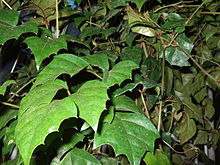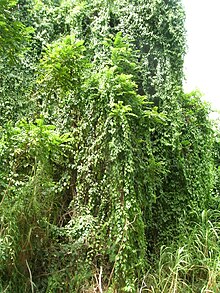Cissus
| Cissus | ||||||||||||
|---|---|---|---|---|---|---|---|---|---|---|---|---|

|
||||||||||||
| Systematics | ||||||||||||
|
||||||||||||
| Scientific name | ||||||||||||
| Cissus | ||||||||||||
| L. |
Cissus is a genus of plants within the grapevine family(Vitaceae). The approximately 350 species are mostly found in the tropics of the Old World and New World . Few species are used as ornamental plants and are sometimes called klimme or house vine.
description





Appearance and leaves
In Cissus TYPES is perennial herbaceous plants or to little to more woody plants upright independently, so as shrubs or climbing , so as lianas grow. Some species are more or less succulent . They can be evergreen or deciduous. The shoot tendrils opposite the foliage leaves are unbranched or bifurcated, sometimes multi-bifurcated.
There are Cissus species with heterophyllia . The alternate and bifurcated or spiral leaves on the stem axis are usually divided into a petiole and a leaf blade. Depending on the species, the leaf blade is divided into simple or palm-shaped three to seven-fold. In the case of hand-shaped spreaders, the lateral leaf sections are often smaller than the end sections. The leaf margins are smooth or serrated. The leaf surfaces are often dotted with glands. The nerve is nervous to the hand and the network nerves can also be recognizable. The stipules fall off early.
Inflorescences and flowers
Cissus species are polygamous, monoecious , but mostly single sexed ( monoecious ); So the flowers of both sexes are on one specimen, but sometimes hermaphrodite flowers also occur, but mostly only hermaphrodite flowers occur. The opposite or near the leaves, usually on long inflorescence shafts, standing, simple more or less doldy inflorescences or compound dichasias contain a few to many flowers. There are bracts , bracts and flower stalks.
The relatively small flowers are fourfold and radial symmetry with a double flower envelope . The four bald sepals are fused cup-shaped and the calyx teeth are only short. The four free petals are hood-shaped at the top and fall off individually. The well-developed, cup-shaped disc has a wavy or slightly four-lobed edge and is fused with the base of the ovary. There is only the inner circle of the stamen with four fertile, identical, free stamens . The two carpels are an above-permanent, two-chambered ovary grown. There are only two ovules per ovary chamber . The conspicuous style ends in a relatively small, simple or two-part scar.
Fruits and seeds
The obovate or ellipsoidal berries are fleshy and usually contain only one or rarely two seeds. The seeds are elliptical, obovate-elliptical or elliptical with a beak-like base and rounded top. The seeds have chalaza nodes at or near their base. The oil-containing endosperm is M-shaped in cross section. The straight embryo has two germ layers ( cotyledons ).
ecology
Some Cissus species (for example Cissus discolor , Cissus nodosa , Cissus quadrangularis , Cissus repens , Cissus rotundifolia , Cissus verticillata ) are invasive plants in some areas of the world.

Systematics and distribution
It was first published in 1753 by Carl von Linné in Species Plantarum , 1 p. 117. Type species is Cissus vitiginea L. The genus name Cissus is derived from the Greek word κισσος ( kissos ) for ivy.
The genus Cissus belongs to the subfamily Vitoideae within the Vitaceae family .
The wide natural range of the genus Cissus includes mainly tropical areas in Asia and Australia , Africa and the Neotropics . There are 15 species in China, two of them only there. Australia is home to around 14 species, seven of which are only there.
There are around 350 species of Cissus , here the species found in China and Australia:
- Cissus adnata Roxb. : It occurs in India , Nepal , Myanmar , Thailand , Laos , Cambodia , Vietnam and in southern Yunnan .
- Rautenblättrige Klimme, Russian wine ( Cissus alata Jacq. , Syn .: Cissus rhombifolia Vahl , Cissus pubescens Kunth , Cissus sulcicaulis var. Alata (Jacq) Hassl.. ): It is in the Neotropics home and (often under the old name Cissus rhombifolia ) used as an ornamental plant.
- Kangaroo Klimme ( Cissus antarctica Vent. ): It occurs in New South Wales and Queensland .
- Cissus aralioides (Welw. Ex Baker) Planch. : From Sudan to Central and West Africa.
- Cissus aristata flower : It is distributed from Hainan and Yunnan via Myanmar, Thailand, Malaysia , Indonesia and the Philippines to Papua New Guinea .
- Cissus assamica (MALawson) Craib : It is distributed from India, Nepal, Bhutan, Cambodia, Thailand to China and Vietnam.
- Cissus austroyunnanensis Y.H.Li & Y.Zhang : It only occurs in Yunnan in forests and scrubland at altitudes between 1600 and 2000 meters.
- Cissus elongata Roxb. : It occurs in India, Bhutan, Malaysia, Singapore, Vietnam and in the Chinese provinces of Guangxi , Hainan and Yunnan.
- Cissus hexangularis Thorel ex Planch. : It occurs in Cambodia, Thailand, Vietnam and in the Chinese provinces of Fujian , Guangdong and Guangxi.
- Cissus hypoglauca A.Gray : It occurs in New South Wales, Victoria and Queensland.
- Multi-leaved Klimme ( Cissus javana DC. , Syn .: Cissus discolor flower ): It is widespread from India, Nepal, Myanmar, Thailand, Vietnam, Malaysia to Indonesia and in the Chinese provinces of Sichuan and Yunnan.
- Cissus kerrii Craib : It occurs in China, India, Indonesia, Thailand, Vietnam and Australia.
- Cissus luzoniensis (Merrill) CLLi : It occurs in Hainan , Yunnan and the Philippines.
- Cissus reniformis Domin : It is native to Australia.
- Cissus repanda Vahl : It occurs in Bhutan, India, Sri Lanka, Thailand, Hainan, Sichuan and Yunnan. It comes in two varieties.
- Cissus repens Lam. : It occurs in Bhutan, Cambodia, India, Laos, Malaysia, Nepal, the Philippines, Thailand, Vietnam, Australia and China.
- Cissus pteroclada Hayata
- Cissus sterculiifolia (F.Muell. Ex Benth.) Planch. : It occurs in New South Wales and Queensland.
- Cissus subtetragona Planch. : It occurs in China, Laos and Vietnam.
- Cissus triloba (Lour.) Merr. : It occurs only in Yunnan and Vietnam.
- Cissus vitiginea L.
- Cissus wenshanensis C.L.Li : It thrives in forests at altitudes of around 1500 meters only in Yunnan.

use
Some Cissus species (mostly Cissus alata and Cissus antarctica and their selection forms) are used as ornamental plants in parks and gardens as well as in rooms.
Parts of the plant are eaten from some species of Cissus .
swell
- Hui Ren & Jun Wen: Cissus , p. 184 - the same text online as the printed work , In: Wu Zheng-yi, Peter H. Raven & Deyuan Hong (Eds.): Flora of China , Volume 12 - Hippocastanaceae through Theaceae , Science Press and Missouri Botanical Garden Press, Beijing and St. Louis 2007. ISBN 978-1-930723-64-1
- HR Coleman, 2008: Entry in the Western Australian flora .
- Maurizio Rossettoac, Betsy R. Jackesb, Kirsten D. Scotta & Robert J. Henry: Is the genus Cissus (Vitaceae) monophyletic? Evidence from plastid and nuclear ribosomal DNA , In: Systematic Botany , 27, Issue 3, 2002, pp. 522-533. doi : 10.1043 / 0363-6445-27.3.522 (currently not available)
Individual evidence
- ↑ a b Gordon Cheers (Ed.): Botanica. The ABC of plants. 10,000 species in text and images. Könemann Verlagsgesellschaft, 2003, ISBN 3-8331-1600-5 , Cissus therein pages 229-230
- ^ A b c d e f C. Gardner & TA James: Cissus in the New South Wales Flora Online .
- ↑ a b c d e f g h i j k Hui Ren & Jun Wen: Cissus , p. 184 - same text online as the printed work , In: Wu Zheng-yi, Peter H. Raven & Deyuan Hong (eds.): Flora of China , Volume 12 - Hippocastanaceae through Theaceae , Science Press and Missouri Botanical Garden Press, Beijing and St. Louis 2007. ISBN 978-1-930723-64-1
- ↑ a b c d e HR Coleman, 2008: Entry in the Western Australian Flora .
- ^ Cissus species at Pacific Island Ecosystems at Risk project = PIER.
- ↑ First published by Linnaeus in 1753, scanned at biodiversitylibrary.org .
- ^ Cissus at Tropicos.org. Missouri Botanical Garden, St. Louis, accessed July 5, 2013.
- ↑ a b Cissus in the Germplasm Resources Information Network (GRIN), USDA , ARS , National Genetic Resources Program. National Germplasm Resources Laboratory, Beltsville, Maryland. Retrieved July 5, 2013.
- ↑ Gerardus JH Grubben (Ed.): Vegetables in Plant resources of tropical Africa , Volume 2, PROTA-Verlag, 2004. ISBN 978-90-5782-147-9 : Google-Books-online. , Cissus species therein pages 183-185

